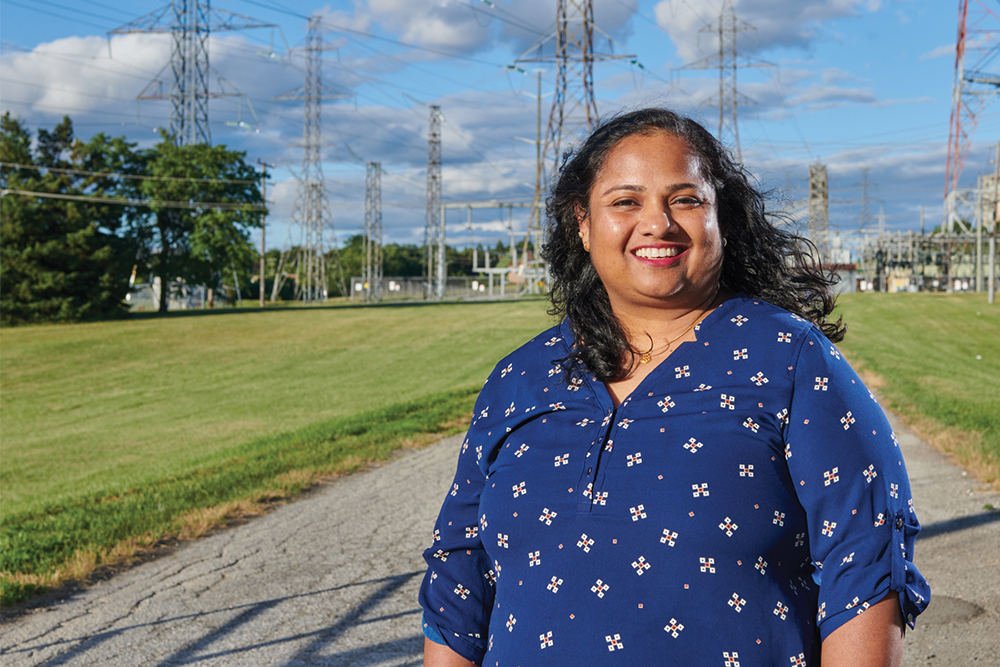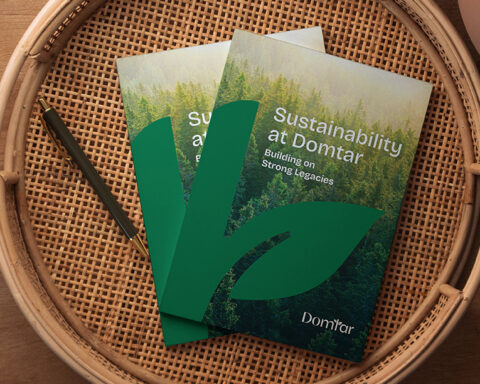We are amid a global climate crisis and it is essential that organizations of all stripes become a part of the solution. CPAs are doing their part by building and sustaining purpose-driven companies that will be vital to bringing about a better future for us all.
This is a global problem, however, to succeed companies, corporations, organizations and governments must work together on innovative solutions. Canada’s green initiatives include everything from companies developing clean energy sources to technology that pulls excess carbon from the atmosphere. While engineers and scientists bring their expertise to the R&D side of the equation, CPAs are creating environments that make innovation possible.
Here are some inspiring stories of CPAs who are driving their organizations towards their net zero, green goals:

Vimali Pathmanathan, Director of Finance, Opus One Solutions, Toronto
Opus One Solutions, a firm that develops software to help energy grids transition to renewables, was acquired by GE Digital in December 2021. Vimali Pathmanathan, Opus One’s director of finance, helped lead the collaboration with GE’s due diligence team. That meant working long hours, weekends and holidays but, for Pathmanathan, leveraging her CPA skills to affect change in real time is part of why she wanted to work in a green-tech start-up.
Pathmanathan spent much of her early career in public accounting; while she enjoyed it, her work was always about taking care of business after the fact. “At Opus One, I always feel like I’m on the frontlines of decision-making. The CEO always says that finance is his right hand. I explore questions like: if we’re going to develop this product line, do we have enough funding? How many people will we need? It’s an exciting way to work.”
Opus One’s software is all about bringing dated grid tech up to speed with clean power. One way to integrate renewables like solar and wind is to transition grids to a distributed model, where they rely on energy sources at several points instead of a single one, like a typical fossil fuel-based power plant. A notable advantage of decentralized grids is their ability to incorporate “behind the meter” (user-side) energy sources like residential solar panels, which in turn encourage individuals and businesses to invest in renewables.
While that’s good news for decarbonization, running a distributed grid is much more complex than a traditional one from a technical perspective. That’s where Opus One comes in. Its flagship GridOS product, which relies on advanced data modelling, allows utility companies to monitor and manage distributed grids for customers like Australian energy company AusNet Services, the U.K.’s SP Energy Networks and, closer to home, Ontario’s Elexicon Energy.
When Pathmanathan applied for the job, she didn’t fully understand Opus One’s mission, but was attracted to the sector’s accelerating growth. Five years in, she’s developed a keen understanding of its technology. “Climate change is impacting everyone. It’s always on my mind,” she says. “I’ve grown with the company and become more committed to its mission in my five years here. What we do here can have a direct impact the planet.”

Greg Twinney, CEO, General Fusion, Burnaby, B.C.
“Despite the financial success and everything else, I felt that there was something missing from my career. I wanted to leave a positive mark on the world,” he says. “When I learned about what General Fusion was doing through a recruiter, I became incredibly attracted to its potential for a massive positive impact outside of just the financial.”
General Fusion’s mission is to provide clean energy to the world with zero emissions and at a cheaper cost than coal. The technology relies on nuclear fusion, where two light atoms fuse to form a single heavier atom, releasing energy as a by-product —not to be confused with nuclear fission, which is the exact reverse of that process and what nuclear power plants currently use.
Fusion research experiments first started the 1930s though first calculations of the rate of nuclear fusion in stars actually started in the 1920s. Scaling it to commercially viable proportions is a monumental engineering challenge—one General Fusion claims to be well on the way to having solved. In 2021, the company announced a public-private partnership for a fusion demonstration plant, which will be operational by 2027.
Twinney sees General Fusion as the culmination of the skills he’s spent a 27-year career acquiring. “From raising capital to scaling up the infrastructure, commercializing and building the right team to do it, these are skills I’ve used before,” he says. “Finance has the unique ability to be the thread that weaves throughout a company and pulls it together. I’ve got a bit of a playbook for executing that and I’m grateful for it because, in my opinion, applying it to General Fusion will dwarf everything I’ve done before.”
The challenge is formidable but, for Twinney, it’s all about the underlying drive. “When you’re taking on a challenge as difficult as commercializing fusion, it really helps to have a deep and meaningful why,” he says. “I often tell investors, there are easier ways to make a buck, but they may not be as rewarding. We’ve been in the labs for a long time, and we’re just now starting to scale up and demonstrate the power of this technology.”

Susan Koch, COO & VP, Carbon Engineering, Vancouver
Green tech start-ups are Susan Koch’s specialty; as a CFO, she’s led companies whose raison d’etre range from electric vehicle fuel cells to nuclear fusion. Now, in her role at a firm that focuses on commercializing carbon capture technology, Koch is making a difference by marrying green tech and accounting.
“It’s an invigorating work environment,” she says. “These companies attract people who want to make a difference. I love working with engineers and scientists, who tend to be bright, curious and have so many interesting ideas.”
Part of Koch’s strength as a finance executive is her eagerness to dig into the science. “At all these jobs, I’ve had to learn about the technical uncertainties and hurdles that need to be overcome to commercialize a technology. That really keeps the job interesting. Eventually, I developed a reasonable understanding that allows me to speak competently about carbon capture or fusion physics to a lawyer or an accountant.”
Carbon capture, she explains, is a sort of industrial tree. Trees (the leaf and bark kind) absorb carbon dioxide as part of their natural role in the carbon cycle, but they can’t keep up with the rate at which humans put carbon into the atmosphere. “Our technology pulls carbon out of the air using what’s called direct air capture (DAC),” she says. “You can do numerous things with the captured carbon, from sequestering it in underground reservoirs to using it to develop cleaner fuel.”
The technology is proven—now, it’s about scaling up to commercial sized plants. Demand depends in part on government policy that’s favourable to clean tech. DAC’s commercial viability in a given jurisdiction is bolstered by climate-forward policies that put a price on CO2 emissions and/or incent the capture of CO2. One good example is a recent addition to California’s Low Carbon Fuel Standard, which now awards credits for each metric ton of CO2 removed and permanently sequestered.
That policy and the US federal 45Q tax credit program haves helped commercialize Carbon Engineering’s expansion in the U.S.; in partnership with development company 1PointFive, the firm is working on a massive Permian Basin project in the southern United States that, when complete, is expected to pull a million tons of CO2 from the air each year. Commercial projects are also underway in Canada, the U.K. and other markets around the world.
In the meantime, Koch’s enthusiasm to learn and her passion for the sector is sure to continue bolstering the firm’s plans to grow their technology to a climate-relevant scale.
Start your journey to net zero today!
Learn how you can play a part as a CPA in helping your organization transition towards net zero with these free resources to design your strategy.
CPA Canada has a wealth of sustainability resources and practical guidance , from reports to reviews of net-zero disclosures and details of our own commitment.
About CPA Canada
Chartered Professional Accountants of Canada (CPA Canada) is one of the largest national accounting organizations in the world and is a respected voice in the business, government, education, and non-profit sectors. It is a progressive and forward-thinking organization whose members bring a convergence of shared values, diverse business skills and exceptional talents to the accounting field. Domestically, CPA Canada works cooperatively with the provincial and territorial CPA bodies who are charged with regulating the profession. Globally, it works together with the International Federation of Accountants and the Global Accounting Alliance to build a stronger accounting profession worldwide. As one of the world’s largest national accounting bodies, CPA Canada carries a strong influential voice and acts in the public interest.








